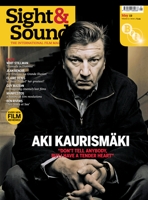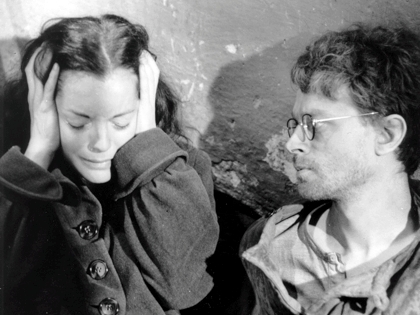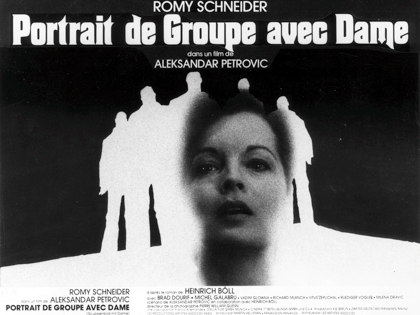Primary navigation


Like so many films by the great Yugoslavian director Aleksandar Petrovic, Group Portrait with Lady is off the radar. By Vlastimir Sudar
from our May 2012 issue
In the mid-1990s, a friend asked me to help track down the films of Aleksandar Petrovic (1929-1994), who had recently died, to screen at a possible retrospective in London. Petrovic was one of the greatest Yugoslav directors, best known for his influential and internationally acclaimed drama I Even Met Happy Gypsies (Skupljaci perja, 1967); since at that time in the 90s armed conflict was tearing Yugoslavia apart, perhaps the idea was to show the country in a different light from the then ubiquitous press coverage. While seeking out the films, I discovered for the first time that Petrovic had made a film outside Yugoslavia, the German/French co-production Group Portrait with Lady (Gruppenbild mit Dame, 1977). It’s a film that has haunted me ever since.
Group Portrait with Lady is an adaptation of the epic German novel that many believe played a key role in winning its writer Heinrich Böll the Nobel Prize in Literature in 1972. Like his other frequently adapted fellow countryman Günter Grass, Böll believed that a writer should operate as the conscience of his nation, and he never flinched from probing the most sensitive issues residing in its collective psyche – the rise of Nazism in the 1930s being the most obvious one. In his voluminous novel Böll explores the period from the rise of fascism to the mid-1960s, when Germany was at the height of its economic boom. Following several key characters, the writer finds some of the roots of fascism in what he sees as the repressively dogmatic culture of the Catholic church; more importantly, however, he emphasises that the spirit powering the post-war economic boom and rapacious capitalist expansion was the same spirit Nazism thrived on.
It was clear to Böll, who collaborated on the script with the Petrovic, that the novel would have to be severely abridged for the screen. Petrovic took charge here, turning this into a World War II story focusing on young German woman Leni Gruyten (played by the Austrian-born star of French cinema, Romy Schneider) and her affairs with two soldiers during the war. In the pre-credits prologue to the film, Petrovic rescues one 1930s episode from the novel, set in the Catholic convent where young Leni was schooled and then expelled. He also sets the final scene in 1960s Germany – the main part of the film is one long flashback narrated by Leni’s wartime employer (played by another stalwart of French cinema, Michel Galabru).
Petrovic was criticised for including these brief snippets of the 1930s and the 1960s, which were seen as unnecessary appendixes inadvertently left hanging. But the director was a modernist who didn’t subscribe to the idea of fixed endings in his work; in this instance, too, he perhaps wanted to provide a framework for his group portrait of wartime Germany. Following the source novel, the rise of Nazism and the economic boom were the necessary bookends to the story.
The film’s portrayal of wartime Germany differs markedly from the usual stereotypes. Leni’s first boyfriend Erhard, an officer in German army, and his younger brother Heinrich have nothing but a profound contempt for the Nazis and their vision of Germany. The two of them decide to escape to Sweden, but fail and are shot as deserters. Leni’s father, a rich industrialist, is exposed as a saboteur of the Reich, and promptly dispatched to a concentration camp. Leni, facing financial ruin, starts working at the local florist, busy making wreaths for dead German soldiers. As the shop can’t handle the demand, a Russian prisoner of war is brought to help out: Boris, a bespectacled young engineer who speaks fluent German (played by the American actor Brad Dourif). Slowly, Boris and Leni fall for each other, and she secures a fake German ID for him. But as Americans enter the city, Boris is arrested as a German soldier, and dies in a French prisoner-of-war camp.
Petrovic directs the story as a low-key chamber piece, creating a quietly languid atmosphere, particularly in the scenes at the florist – albeit an atmosphere overshadowed by ominous events outside. Only in one scene does he throw down the gauntlet, foregrounding the war and revealing the film as a high-budget affair. Allied bombardments provide the spectacle as the city’s buildings are torn apart, but it’s a rapid montage of the overexposed faces of those who are bombed that’s most affecting – bringing home the horrors of the war in the most immediate way.
As Leni, Romy Schneider effortlessly embodies the character’s confident persona, which only slips during her breakdown in a bombed-out shelter. Brad Dourif – fresh from his breakthrough role in One Flew over the Cuckoo’s Nest (1975) for another itinerant East European, Milos Forman – is also convincing as an intelligent and educated Russian, cautiously coy in a hostile environment. With Galabru and New German Cinema regular Rüdiger Vogler in supporting roles, the stellar international cast shows that this was a major arthouse affair, not without a whiff of Europudding about it. But Petrovic’s use of a multinational cast also has a point, expanding the book’s notion that wars between nations are futile affairs, since nations themselves are fragile constructs – the film ends with a Russian buried in a German grave. So it’s a shame the Petrovic retrospective we researched never materialised, as screening this anti-war film by a Yugoslav director would have been all too timely in the mid-1990s, as his country fell apart.
Group Portrait with Lady premiered in Cannes in 1977, but is now completely unavailable, while all of Petrovic’s films remain very hard to come by even in his native Serbia. This is mainly because one of the largest studios of Socialist Yugoslavia – Avala Film in Belgrade, which produced his home-grown films – has been teetering on the edge of bankruptcy since the break-up of the country, and its precious back-catalogue seems to be forgotten.
Group Portrait, however, is not in that treasure trove – in fact it had backing from United Artists. Considering its A-list arthouse cast, its disappearance below the radar is perplexing – all the more so since the frank manner in which it deals with the greatest tragedy of the 20th century makes it a searing reminder of the futility of armed conflicts.

“It’s appropriate that this portrait of the German war tragedy be done by a foreign helmer, not by a native one – for critical repercussions might possibly outweigh the integrity of the theme, and a backlash could result… Credits are top-notch, particularly Pierre-William Glenn’s lensing of the greenhouse to lend mood and atmosphere to the main line of story. Performance by Romy Schneider is a good cut above her usual star status… Galabru as the greenhouse proprietor steals some scenes, but it’s he who gives the story its unity by drawing all the characters together. Dourif is more than credible as the starving Russian POW. United Artists may have a critical winner at Cannes.”
— Variety, 21 May 1977
The great escape: Linda Ruth Williams on La Grande Illusion (May 2012)
If Not Us, Who? reviewed by Catherine Wheatley (April 2012)
Hotel Terminus: The Life and Times of Klaus Barbie reviewed by Nick James (January 2011)
Manhunt reviewed by Tim Lucas (March 2010)
Sleeping with the enemy: Linda Ruth Williams on Black Book (February 2007)
Into the Arms of Strangers Stories of the Kindertransport reviewed by Stella Bruzzi (December 2000)